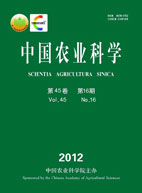-
Method of Making Pear Fruit-Derived Nutrient Solution and Its Effect on Photosynthetic Characteristics and Fruit Quality
- LUO Rui, ZHANG Jie, LIU Ming-Juan, JI Qian-Long, YAO Yun-Cong
-
Scientia Agricultura Sinica. 2012, 45(16):
3337-3345.
doi:10.3864/j.issn.0578-1752.2012.16.013
-
 Abstract
(
1182 )
Abstract
(
1182 )
 PDF (615KB)
(
840
)
PDF (615KB)
(
840
)
 Save
Save
-
References |
Related Articles |
Metrics
【Objective】The purpose of this study is to explore the optimal method of making pear fruit-derived nutrient solution and its effect on photosynthetic characteristics and fruit quality.【Method】In the present study, the dropping and thinning fruits from pear tree, Pyrus pyrifolia(Burm.f.).cv. Nakai, were used as materials to make the nutrient solutions and different formula including content of sugar and water, disintegrating status of fruit, anaerobic or aerobic condition and fermentation days were designed to study their effects on the nutrition components in the solutions. Furthermore, in order to analyze the mineral element content, growth status and the photosynthetic characteristics of pear trees, a pear fruit-derived nutrient solution was made based on the optimal formula and sprayed with different concentrations of the pear fruit-derived nutrient solution (Tr1 for 500 times, Tr2 for 200 times, and Tr3 for 0 times as CK) on two-year-old pear trees and fifteen-year-old mature trees.【Result】The results indicated that young pear fruit, ferments, brown sugar and water according to the mass ratio of 50:1:10:35 in the fermentation conditions of fruit homogenate, aerobic conditions at room temperature of 25-28℃ for 30 to 45 days were the most suitable formula to make fruit-derived nutrient solution, and spray with pear fruit-derived nutrient solution significantly increased leaf thickness, the specific leaf weight, the content of chlorophyll, and the content of mineral element, such as N, P, K, Ca, Fe, Mn and so on. In addition, spray with pear fruit-derived nutrient solution not only enhanced the water use efficiency through increased the net photosynthetic rate and decreased the transpiration rate, but also significantly increased the average single fruit weight, fruit-based index, fruit hardness, soluble solids, titratable acid, sugar acid ratio and Vc content.【Conclusion】In conclusion, spraying on the surface of leaves significantly promoted the growth of pear trees, increased the content of mineral element in leaves, enhanced the photosynthetic performance of leaves, further then improved the quality of fruits, especially the 200 times nutrient solution. And the product made by the optimal formula had higher content of mineral elements, degree of decomposition and content of sugar than others.









